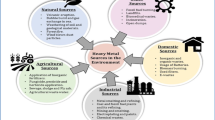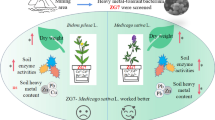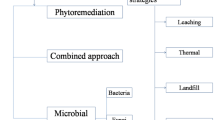Abstract
The study of soil cadmium (Cd) fractionation has become the need of the hour due to phytoextraction of Cd heavy metal by indigenous Brassica species of northwest India. The present study was conducted to explore the Cd speciation in soils treated with Cd (0, 5.0, 10.0, 20.0, 40.0, and 80.0 mg kg−1 soil) and synthetic chelate ethylene diamine tetraacetic acid (EDTA-0, 1.0 and 2.0 g kg−1 soil) planted under three Brassica species (Brassica juncea L., Brassica campestris L., and Brassica napus L). The studied Cd fractions viz. exchangeable and water-soluble (EX + WS), carbonate (CARB), organic matter (OM), Mn oxide (MnOX), amorphous Fe oxide (AFeOX), crystalline Fe oxide (CFeOX), and residual (RES) differed in their Cd content in soils under three investigated Brassica species. Among all plantations, B. juncea reduced the highest soil Cd content of EX + WS form which reflected its bioavailability. The Cd supplementation significantly enhanced the Cd concentration in all Cd forms with EX + WS Cd form exhibiting higher increase even at low Cd level (5.0 mg kg−1), whereas the EDTA addition did not influence Cd fractions. The application of EDTA @ 1.0 g kg−1 soil proved beneficial as it enhanced the metal mobility for plant extraction. All species positively significantly correlated (r = 0.648** to 0.747**) with all Cd fractions but except B. juncea all confronted reduction in their total biomass. In nutshell, it suggested that Brassica species having large plant biomass could be considered as a potential candidate for phytoremediation.




Similar content being viewed by others
Data availability
The data will be available from authors on request.
References
Ahemad, M. (2019). Remediation of metalliferous soils through the heavy metal resistant plant growth promoting bacteria: Paradigms and prospects. Arabian Journal of Chemistry, 12(7), 1365–1377. https://doi.org/10.1016/j.arabjc.2014.11.020
Akhtar, F. Z., Archana, K. M., Krishnaswamy, V. G., & Rajagoparl, R. (2020). Remediation of heavy metals (Cr, Zn) using physical, chemical and biological methods: A novel approach. S N Applied Sciences, 2, 267. https://doi.org/10.1007/s42452-019-1918-x
Balali-Mood, M., Naseri, K., Tahergorabi, Z., Khazdair, M. R., & Sadeghi, M. (2021). Toxic mechanisms of five heavy metals: Mercury, lead, chromium, cadmium, and arsenic. Frontiers in Pharmacology, 12, 643972. https://doi.org/10.3389/fphar.2021.643972
Benavides, B. J., Drohan, P. J., Spargo, J. T., Maximova, S. N., Guiltinan, M. J., & Miller, D. A. (2021). Cadmium phytoextraction by Helianthus annuus (sunflower), Brassica napus cv Wichita (rapeseed), and Chyrsopogon zizanioides (vetiver). Chemosphere, 265, 129086. https://doi.org/10.1016/j.chemosphere.2020.129086
Bonanno, G. (2011). Trace element accumulation and distribution in the organs of Phragmites australis (common reed) and biomonitoring applications. Ecotoxicology and Environmental Safety, 74, 1057–1064.
Briffa, J., Sinagra, E., & Blundell, R. (2020). Heavy metal pollution in the environment and their toxicological effects on humans. Heliyon, 6(9), e04691. https://doi.org/10.1016/j.heliyon.2020.e04691
Caunii, A., Negrea, A., Pentea, M., Samfira, I., Motoc, M., & Butnariu, M. (2015). Mobility of heavy metals from soil in the two species of the aromatic plants. Revista De Chimie (bucharest), 66(3), 382–386.
Chao, T. T. & Zhou, L. (1983). Accumulation and effect of cadmium on crops. In Proc 1st international cadmium conference, Metal Bullet limited, London, pp. 125–140.
Chao, T. T. (1972). Selective dissolution of manganese oxides from soils and sediments with acidified hydroxylamine hydrochloride. Soil Science Society of America Journal Proceedings, 36, 764–768.
Dhaliwal, S. S., Sharma, V., Taneja, P. K., Shukla, A. K., Kaur, L., Verma, G., Verma, V. & Singh, J. (2021). Effect of cadmium and ethylenediamine tetraacetic acid supplementation on cadmium accumulation by roots of brassica species in Cd spiked soil. Environmental Science and Pollution Research, https://link.springer.com/article/10.1007%2Fs11356-021-16084-7.
Dhaliwal, S. S., Taneja, P. K., Singh, J., Bhatti, S. S., & Singh, R. (2020). Cadmium accumulation potential of brassica species grown in metal spiked loamy sand soil. Soil and Sediment Contamination: An International Journal, 29, 638–649. https://doi.org/10.1080/15320383.2020.1758031
Feszterová, M., Porubcová, L., & Tirpáková, A. (2021). The monitoring of selected heavy metals content and bioavailability in the soil-plant system and its impact on sustainability in agribusiness food chains. Sustainability, 13, 7021.
Garcia-Salgado, S., Garcia-Casillas, D., Quijano-Nieto, M. A., & Bonilla-Simon, M. M. (2012). Arsenic and heavy metal uptake and accumulation in native plant species from soils polluted by mining activities. Water Air and Soil Pollution, 223, 559–572.
Ghazaryan, K., Movsesyan, H., Ghazaryan, N., & Watts, B. A. (2019). Copper phytoremediation potential of wild plant species growing in the mine polluted areas of Armenia. Environmental Pollution, 249, 491–501.
Guerra Sierra, B. E., Muñoz Guerrero, J., & Sokolski, S. (2021). phytoremediation of heavy metals in tropical soils an overview. Sustainability, 13, 2574. https://doi.org/10.3390/su13052574
Honma, T., Ohba, H., Makino, T., & Ohyama, T. (2015). Relationship between cadmium fractions obtained by sequential extraction of soil and the soil properties in contaminated and uncontaminated paddy soils. Journal of Chemistry. https://doi.org/10.1155/2015/714680
Jackson, M. L. (1973). Soil chemical analysis. Prentice hall of India Pvt Ltd.
Kabala, C., & Singh, B. R. (2006). Distribution and forms of cadmium in soils near a copper smelter. Polish Journal of Environmental Studies, 15(2a), 90–97.
Kaur, B., Singh, B., Kaur, N., & Singh, D. (2018). Phytoremediation of cadmium-contaminated soil through multipurpose tree species. Agroforestry Systems, 92, 473–483. https://doi.org/10.1007/s10457-017-0141-2
Keller, V., & Vedy, J. C. (1994). Distribution of copper and cadmium fractions in two forest soils. Journal of Environmental Quality, 23(5), 987–999.
Khanmirzaei, A., Bazargan, K., Amir Moezzi, A., Richards, B. K., & Shahbazi, K. (2013). Single and sequential extraction of cadmium in some highly calcareous soils of southwestern Iran. Journal of Soil Science & Plant Nutrition, 13(1), 153–164.
Khurana, M. P. S. (2000). Transformation and bioavailabilty of cadmium in alluvial soils as influenced by cadmium, manures and Zinc application. PhD Dissertation, Punjab Agricultural University.
Lindsay, W. L., & Norvell, W. A. (1978). Development of a DTPA soil test for zinc, iron, manganese and copper. Soil Science Society of America Journal, 42, 421–428.
Merwin, H. D., & Peech, M. (1950). Exchangeability of soils potassium in the sand, silt and clay fractions as influenced by the nature of the complementary exchangeable cations. Soil Science Society of America Journal Proceedings, 15, 125–128.
Nouairi, I., Ammar, W. B., Youssef, N., Daoud, D. B. M., Ghorbal, M. H., & Zarrouk, M. (2006). Comparative study of cadmium effects on membrane lipid composition of Brassica juncea and Brassica napus leaves. Plant Science, 170, 511–519. https://doi.org/10.1016/j.plantsci.2005.10.003
Olsen, S. R., Cole, C. V., Watanabe, F. S., & Dean, L. A. (1954). Estimation of available phosphorus by extraction with sodium bicarbonate. US Departmental Agricultural Circular, 939, 1–19.
Peco, J. D., Higueras, P., Campos, J. A., Olmedilla, A., Romero-Puertas, M. C., & Sandalio, L. M. (2020). Deciphering lead tolerance mechanisms in a population of the plant species Biscutella auriculata L. from a mining area: Accumulation strategies and antioxidant defenses. Chemosphere, 261, 127721.
Pinto, A. P., Mota, A. M., De Varennes, A., & Pinto, F. C. (2004). Influence of organic matter on the uptake of cadmium, zinc, copper and iron by sorghum plants. Science of Total Environment, 326, 239–247.
Pulford, I. D., & Watson, C. (2003). Phytoremediation of heavy metal contaminated land by trees-a review. Environment International, 29, 529–540.
Shuman, L. M. (1982). Separating soil iron and manganese oxide fractions for micro element analysis. Soil Science Society of America Journal, 46, 1099–1102.
Shuman, L. M. (1991). Chemical forms of micronutrients in soils. In J. J. Mortvedi, P. M. Giordano, & W. L. Lindsay (Eds.), Micronutrients in agriculture (pp. 113–144). SSSA Book Series. https://doi.org/10.2136/sssabookser4.2ed.c5
Shuman, L. M. (1983). Sodium hypo chloride methods for extracting micro elements associated with soil organic matter. Soil Science Society of America Journal, 47, 656–660.
Singh, J. P., Karwasra, S. P. S., & Singh, M. (1988). Distribution and forms of copper, iron, manganese and zinc in calcareous soils of India. Soil Science, 146(5), 359–366.
Song, Y., Zhang, F., Li, H., Qiu, B., Gao, Y., Cui, D., & Yang, Z. (2020). Antioxidant defense system in lettuces tissues upon various as species exposure. Journal of Hazard Materials, 399, 123003.
Su, D., Xing, J., Jiao, W., & Wong, W. (2009). Cadmium uptake and speciation changes in the rhizosphere of cadmium accumulator and non-accumulator oilseed rape varieties. Journal of Environmental Sciences, 21, 1125–1128.
Tessier, A., Campbell, P. G. C., & Bission, M. (1979). Sequential extraction procedure for the speciation of particulate trace metals. Analytical Chemistry, 51, 844–851.
Xia, S., Deng, R., Zhang, Z., Liu, C., & Shi, G. (2016). Variations in the accumulation and translocation of cadmium among pak choi cultivars as related to root morphology. Environmental Science and Pollution Research, 23, 9832–9842.
Yan, A., Wang, Y., Tan, S. N., Yusof, M. L. M., Ghosh, S., & Chen, Z. (2020). Phytoremediation: A promising approach for revegetation of heavy metal-polluted land. Frontiers in Plant Science, 11, 359. https://doi.org/10.3389/fpls.2020.00359
Ying, R., Xia, B., Zeng, X., Qiu, R., Tang, Y., & Hu, Z. (2021). Adsorption of cadmium by Brassica juncea (L.) czern. and Brassica peknensis (Lour.) rupr in pot experiment. Sustainability, 14, 429. https://doi.org/10.3390/su14010429
Zwolak, A., Sarzyńska, M., Szpyrka, E., & Stawarczyk, K. (2019). Sources of soil pollution by heavy metals and their accumulation in vegetables: A review. Water Air and Soil Pollution, 230, 164. https://doi.org/10.1007/s11270-019-4221-y
Acknowledgements
The authors thanks the Director of Research, Punjab Agricultural University, Ludhiana
Funding
No Funding is available.
Author information
Authors and Affiliations
Contributions
Concept of the research work was designed by SSD, VS and AKS. The research work was performed by PKT, LK and JK. The formal analysis was carried out by VS and PKT. The writing—original draft preparation was accrued out by LK, VV, MK and JK. The final review and editing was done by SSD, LK.
Corresponding author
Ethics declarations
Conflict of interest
The Authors declare that there is no conflict of interest.
Additional information
Publisher's Note
Springer Nature remains neutral with regard to jurisdictional claims in published maps and institutional affiliations.
Rights and permissions
About this article
Cite this article
Dhaliwal, S.S., Sharma, V., Shukla, A.K. et al. Exploration of Cd transformations in Cd spiked and EDTA-chelated soil for phytoextraction by Brassica species. Environ Geochem Health 45, 8897–8909 (2023). https://doi.org/10.1007/s10653-022-01260-6
Received:
Accepted:
Published:
Issue Date:
DOI: https://doi.org/10.1007/s10653-022-01260-6




